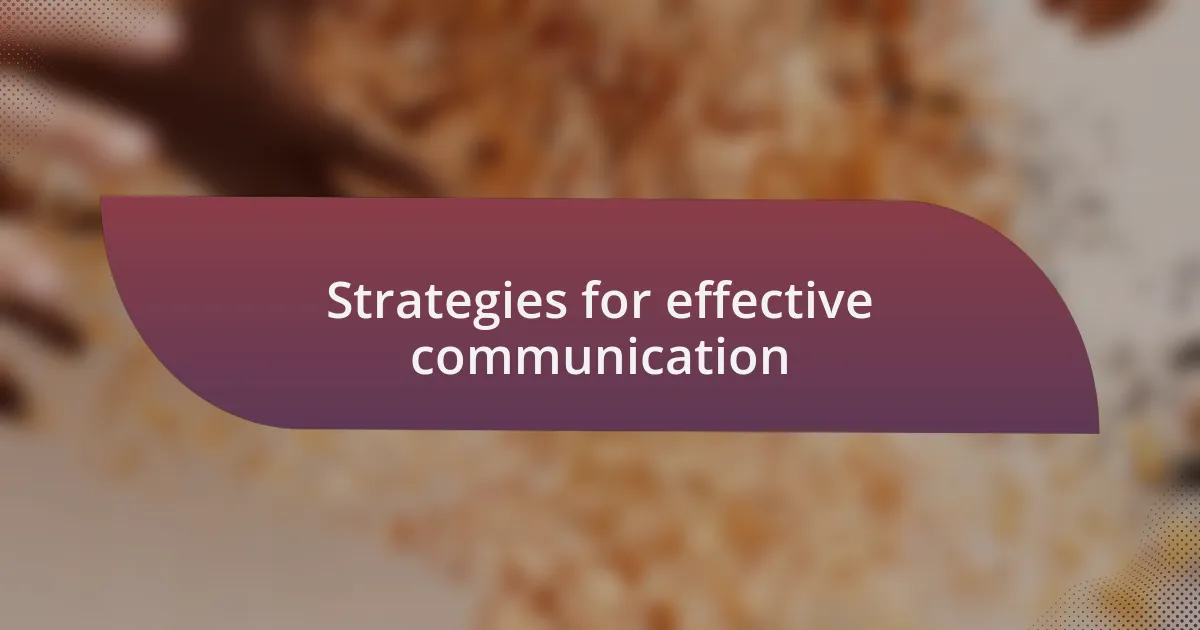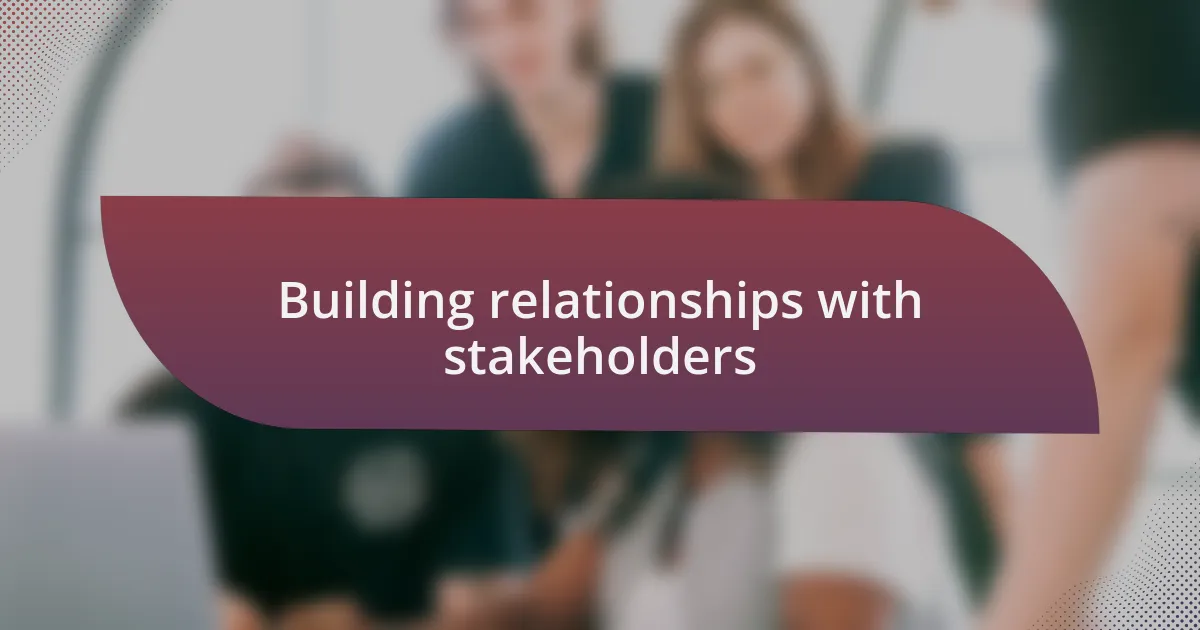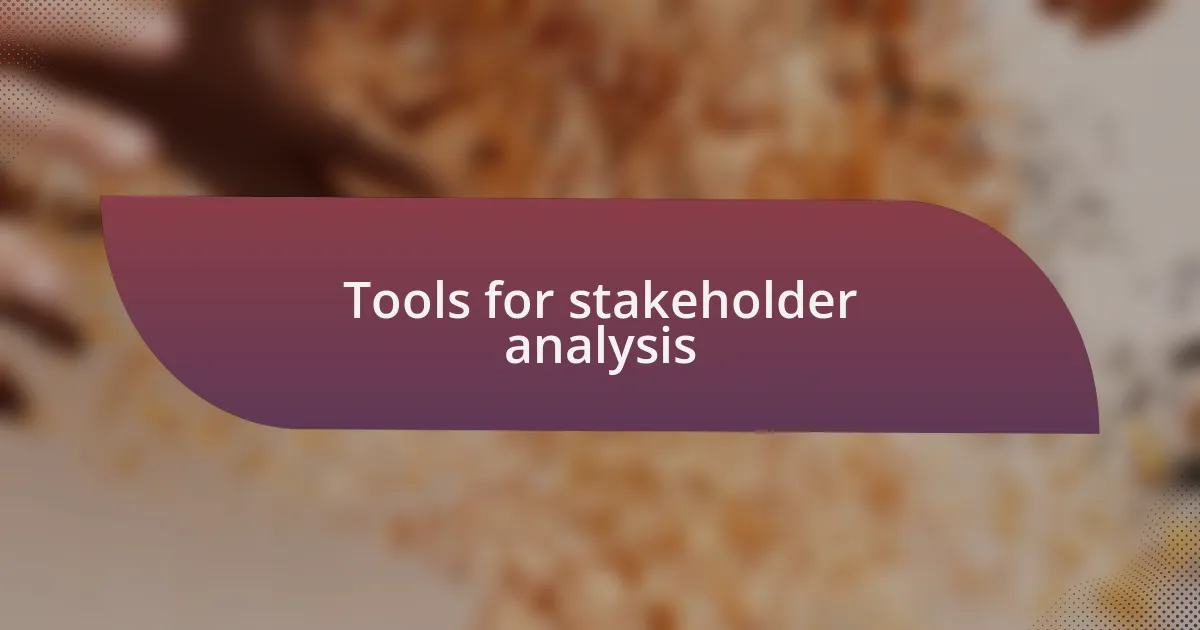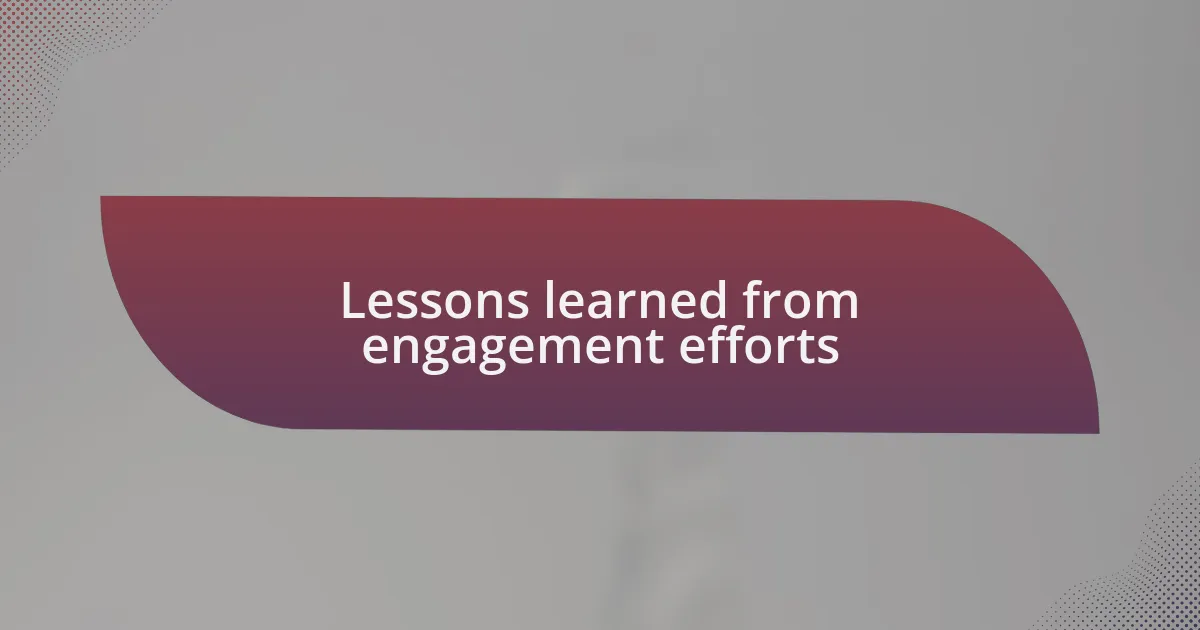Key takeaways:
- Listening to diverse stakeholders reveals unique perspectives and fosters inclusive dialogue, helping find common ground.
- Effective stakeholder engagement leads to comprehensive solutions, holds emotional investment, and transforms participation into ownership.
- Utilizing active listening, visual aids, and regular feedback loops enhances communication and builds trust among stakeholders.
- Building authentic relationships through empathy, follow-ups, and co-creation strengthens partnerships and promotes collaboration.

Understanding diverse stakeholders
Understanding diverse stakeholders requires an appreciation of their unique perspectives and experiences. I’ve found that listening to their stories often reveals underlying motivations and concerns that can shape our approach. For instance, during a recent project, I engaged with community leaders from vastly different backgrounds. The varying viewpoints made me realize how critical it is to create inclusive dialogues.
When I think about diverse stakeholders, I often ask myself: what truly drives them? This question has led me to uncover shared values that resonate across different groups. I remember a workshop where representatives from NGOs and local businesses came together. Initially, there was tension, but as we shared our challenges and aspirations, a sense of camaraderie developed. This is where the magic happens—when stakeholders discover common ground amidst their differences.
It’s not just about managing relationships; it’s about nurturing them. I’ve learned that showing genuine empathy can transform interactions. I once worked with a group that felt their voices were not being heard in policy discussions. By validating their concerns and actively including them in the decision-making process, we fostered trust. This experience taught me that understanding diverse stakeholders means valuing their input, which enriches our collective outcomes.

Importance of stakeholder engagement
Engaging stakeholders is not just a procedural task; it’s a cornerstone of effective policy-making. In my experience, involving diverse voices leads to more comprehensive solutions. I remember a project where we brought together various community members, including marginalized groups. The insights we gained were invaluable, revealing gaps in our initial understanding and helping us craft a policy that truly resonated with the community. It’s amazing how these conversations can illuminate pathways that might otherwise go unnoticed.
When stakeholders feel valued, they’re more likely to engage actively, fostering a sense of ownership over the process. I once collaborated on a health initiative with local organizations and citizens who shared their experiences with healthcare access. Their stories were eye-opening and shifted our approach significantly. It made me realize how much richer our discussions became when stakeholders saw themselves as part of the decision-making team. Do we always recognize the strength that diverse insights bring to the table?
The emotional investment of stakeholders can be a powerful catalyst for change. I’ve witnessed firsthand how engagement can transform apathy into enthusiasm. In a recent endeavor, I found that when we took the time to address the fears and hopes of a hesitant community group, we not only built trust, but also ignited their passion to be advocates for their own interests. This taught me that effective stakeholder engagement creates not just policies, but a supportive network built on shared goals and mutual respect.

Strategies for effective communication
Strategies for effective communication should center on active listening. I recall a situation during a focus group session where it became clear that participants felt unheard. Rather than interjecting with my own opinions, I made a conscious effort to listen deeply to their concerns. By reflecting back what I heard, I fostered an environment where everyone felt their input was valued. This simple shift not only built trust but also drew out more candid and meaningful responses.
Utilizing visual aids can also enhance understanding and engagement. In a recent workshop, I introduced infographics to illustrate complex data. The impact was immediate; people were no longer staring blankly at charts but instead engaging in lively discussions. Visuals helped bridge gaps in understanding across different backgrounds, making it easier for everyone to connect with the content. Have you ever tried using images or graphics to clarify your message? It can be a game-changer.
Regular feedback loops are another essential strategy. After a recent community engagement session, I sent out quick surveys to gather insights from the participants. Their feedback was eye-opening, revealing aspects of the conversation I hadn’t considered. This process not only improved our future interactions but also demonstrated that we genuinely valued their opinions. By fostering a culture of continuous feedback, I learned that communication evolves and strengthens, creating a more inclusive space for dialogue.

Building relationships with stakeholders
Building relationships with stakeholders requires an authentic approach rooted in empathy and understanding. I remember the first time I met with a community leader who was initially skeptical of our initiatives. Instead of presenting my agenda, I took the time to ask about their experiences and the needs of their community. Listening to their stories not only laid the foundation for trust but also opened the door for collaboration that I didn’t think was possible before.
In my experience, following up after initial meetings can solidify those connections. I once reached out to a stakeholder a month after a discussion to see how our proposed ideas were resonating with their audience. To my surprise, they shared feedback that led to adjustments in our plans, making them more relevant. Isn’t it rewarding when a simple follow-up transforms a one-time meeting into a lasting partnership?
Moreover, creating shared experiences can significantly enhance relationships. During a joint project, I invited stakeholders to co-design solutions rather than just presenting them with finished concepts. I watched how engagement flourished as we brainstormed together. This collaboration brought out passionate insights and fostered a sense of ownership that made everyone feel invested in the outcomes. Have you ever tried involving stakeholders in the creative process? It can shift the dynamics dramatically.

Tools for stakeholder analysis
Tools for stakeholder analysis are essential in understanding the landscape of relationships and influences in any project. One effective tool I’ve utilized is the Stakeholder Mapping Matrix. By categorizing stakeholders based on their level of interest and influence, I’ve gained clarity on where to focus my engagement efforts. I remember when I mapped out a project’s stakeholders and realized that a seemingly minor local business owner held significant sway in the community. Engaging their support was pivotal, and understanding their position changed the game for us.
Another valuable method is conducting stakeholder interviews. This process allows me to gather qualitative insights directly from the individuals involved. I once interviewed a group of educators whose feedback reshaped our approach to educational policy proposals. Their perspectives were enlightening, revealing nuances I hadn’t considered before. Don’t you think that hearing directly from those affected can illuminate blind spots we might overlook?
Lastly, I find that using surveys can effectively gauge stakeholder sentiment and expectations. In my previous project, I distributed a simple questionnaire to gather feedback on our initiatives. The results were telling; they not only highlighted areas for improvement but also showcased unexpected support for ideas we were hesitant about. Have you ever realized that what you perceive as contentious might actually have strong backing? This tool can validate assumptions and guide our strategies in compelling ways.

Personal experiences in engagement
When I reflect on my personal experiences in engaging diverse stakeholders, I often think about a community forum I organized focused on local health initiatives. I was surprised by the passion and energy in the room, especially from residents who initially seemed disengaged. Their stories were powerful, and it struck me how understanding their challenges allowed me to connect with them on a deeper level. Isn’t it fascinating how just a space for dialogue can uncover so much?
In another instance, I collaborated with a group of non-profit leaders who represented various cultural backgrounds. Something that stood out was the differing expectations of engagement; while some preferred direct communication, others valued a more formal approach. Navigating these preferences taught me the importance of flexibility in my approach. How do we truly accommodate these varied styles without diluting our message? As I learned, creating a tailored engagement strategy was critical in ensuring we not only communicated but also experienced genuine interaction.
I remember a time when I faced resistance from a group of policymakers who were skeptical about our project. Instead of pushing back, I invited them to participate in a brainstorming session. By fostering an environment of collaboration rather than confrontation, I could see their defenses lowering, and they began to share their insights openly. Have you ever turned a skeptic into an ally simply by listening? It was one of those moments where I felt the true power of inclusive engagement; the breakthrough came when we shifted from a transactional relationship to a partnership built on trust.

Lessons learned from engagement efforts
Engagement efforts have taught me that patience is often the unsung hero of effective communication. During a multi-stakeholder workshop, I learned that active listening is just as important as presenting information. I vividly recall a moment when I paused to let silence linger after a challenging question; the room eventually filled with thoughtful responses, revealing insights I hadn’t anticipated. Have you ever experienced how silence can sometimes speak louder than words? It became clear to me that giving space can lead to deeper reflections and richer discussions.
Another lesson emerged when I realized that vulnerability can foster trust. I once shared my own hesitations about a proposed policy, admitting that I, too, was learning in the process. It was a risk, but it opened the floodgates for others to share their uncertainties and experiences. I was amazed by how quickly a sense of camaraderie developed among participants. Could it be that our shared vulnerabilities make us more relatable and approachable? This experience showed me that transparency can create a safe space for dialogue, enriching the engagement experience for everyone involved.
Finally, I’ve learned about the power of follow-up. After a series of discussions, I ensured to send out a summary of our conversations and the next steps we were taking based on their feedback. The positive responses were overwhelming, and I realized that this simple act not only reinforced that their voices mattered but also strengthened our collaborative efforts. What if we all took the time to acknowledge contributions beyond the meeting room? This approach can significantly enhance our relationships and commitment to shared goals.